Northwest’s Wildlife Services Team specializes in the exclusion, removal, and control of animal nuisances. Among our specialties are squirrels, rodents, raccoons, opossums, bees, armadillos, and chipmunks. An important wildlife service in the coming warm months is our snake removal! Our Wildlife team uses a Green product that is used to deter snakes. We also spend a great deal of time educating the customer on snakes.
Georgia is among the states with the highest biodiversity of snakes in the U.S. with 43 different species. They are located anywhere in Georgia from the mountains in the north to the barrier islands along our eastern coast. Below we have pictures and descriptions of the most common venomous snakes. If you spot one of these, call our Wildlife Services Team at 770.436.3362 to get them off your hands, or better yet, remove them very far away from your hands!
Copperhead
Copperheads are fairly large – anywhere from 2 to over 3 feet long! They have brown, triangular heads and elliptical pupils. You likely won’t want to get close enough to be sure, but they have two tiny dots at the center of the top of the head. More distinguishing features include yellow tails for juvenile snakes, and the brown bands that run along their body are in a distinct hourglass shape. They are found mostly in the forested areas of Georgia and South Carolina.
Cottonmouth/Water Moccasin
Just like copperheads, cottonmouths have large, triangular heads with elliptical pupils. They get the name water moccasin from their semi-aquatic nature and are likely to be found by mostly all types of freshwater habitats. These are more difficult to identify by appearance because they have a wide range of colors but tend to feature colors that will camouflage them into their habitats.
Eastern Diamondback Rattlesnake
Eastern diamondbacks are among the largest of 32 species of rattlesnakes, ranging anywhere from 2.75 feet to 6 feet long. They have large, broad heads with two light lines on their faces. These are easily recognized by their brown diamonds, surrounded by lighter colored brown, tan or yellowish scales. They can be located anywhere from the southern part of North Carolina, but especially in South Georgia and Florida. They like to be in drier, sandy or low cut grass areas and tend to avoid wetter areas, though they are great swimmers and even travel through saltwater!
Canebrake/Timber Rattlesnake
These snakes tend to range from about 3-5 feet in length and are usually gray with a pink, yellow, orange or brown stripe running along their back. They have solid black tails and black chevrons along the back and sides of their body with the point of the (V) pointing forward. They are found in most of the eastern United States, but are somewhat absent from Florida. They can be found in a wide range of areas, but are least likely to be found in highly urbanized or residential areas.
Pigmy Rattlesnake
This rattlesnake is on the smaller side, usually coming in at under 2 feet in length. This snake has 9 large scales on the top of it’s head and a tiny rattle that can rarely be heard. They have a row of mid-dorsal spots and a bar from the eye to their mouth that ranges from black to brownish. The name is deceptive as they can be gray, tan, lavender, orange, red, or even black. These are mostly located from central Georgia up throughout South Carolina. They also like to be near water sources like creeks, marshes, and swamps.
Eastern Coral Snake
“Red on yellow, kills a fellow. Red on black, friend of Jack.” These snakes are sometimes up to 4 feet in length with smooth heads with a bright body pattern of black rings in which the red and yellow rings touch each other. These are sometimes confused with king snakes, but these snakes only have the red touching the black rings and are not venomous. These snakes are found all the way from Louisiana to Florida, where they are most prevalent. They are rarely spotted because they hide under ground and spend only a limited time crawling above ground. Unfortunately, because of these secretive habits, coral snakes tend to persist in suburban areas.
Melissa Brown
[email protected]
Sources:
http://georgiawildlife.com/node/497
https://uga.edu/srelherp/snakes/index.htm
http://srelherp.uga.edu/snakes/pics/agkcon210.jpg
http://srelherp.uga.edu/snakes/pics/agkpis210.jpg
http://srelherp.uga.edu/snakes/pics/agkpis4.jpg
http://srelherp.uga.edu/snakes/pics/croada210.jpg
http://srelherp.uga.edu/snakes/pics/crohor3.jpg
http://srelherp.uga.edu/snakes/pics/sismil210.jpg
http://www.petmd.com/sites/default/files/coral_snake.gif

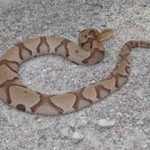
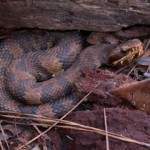
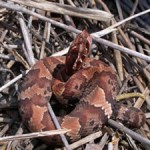
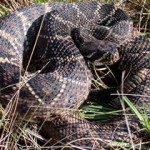
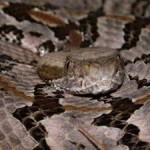
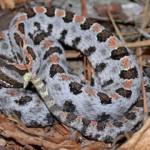
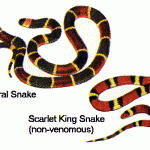
Can you tell me if there are Cottonmouths in Cobb County? I have heard that they do not go above the fall line. I am in and around the water almost every day. Although I’ve seen many Copperheads in Cobb, and a dead Canebrake ( Timber?) Rattler once in the 38 years I’ve lived in Cobb County, I’ve never seen a Cottonmouth. Have you?
Thanks.
Bill
Hi Bill, yes cottonmouths are common throughout Georgia, near any body of freshwater. So use caution when in and around the water. Here’s some more info on water moccasins/cottonmouths – water moccasins. Hope this helps!